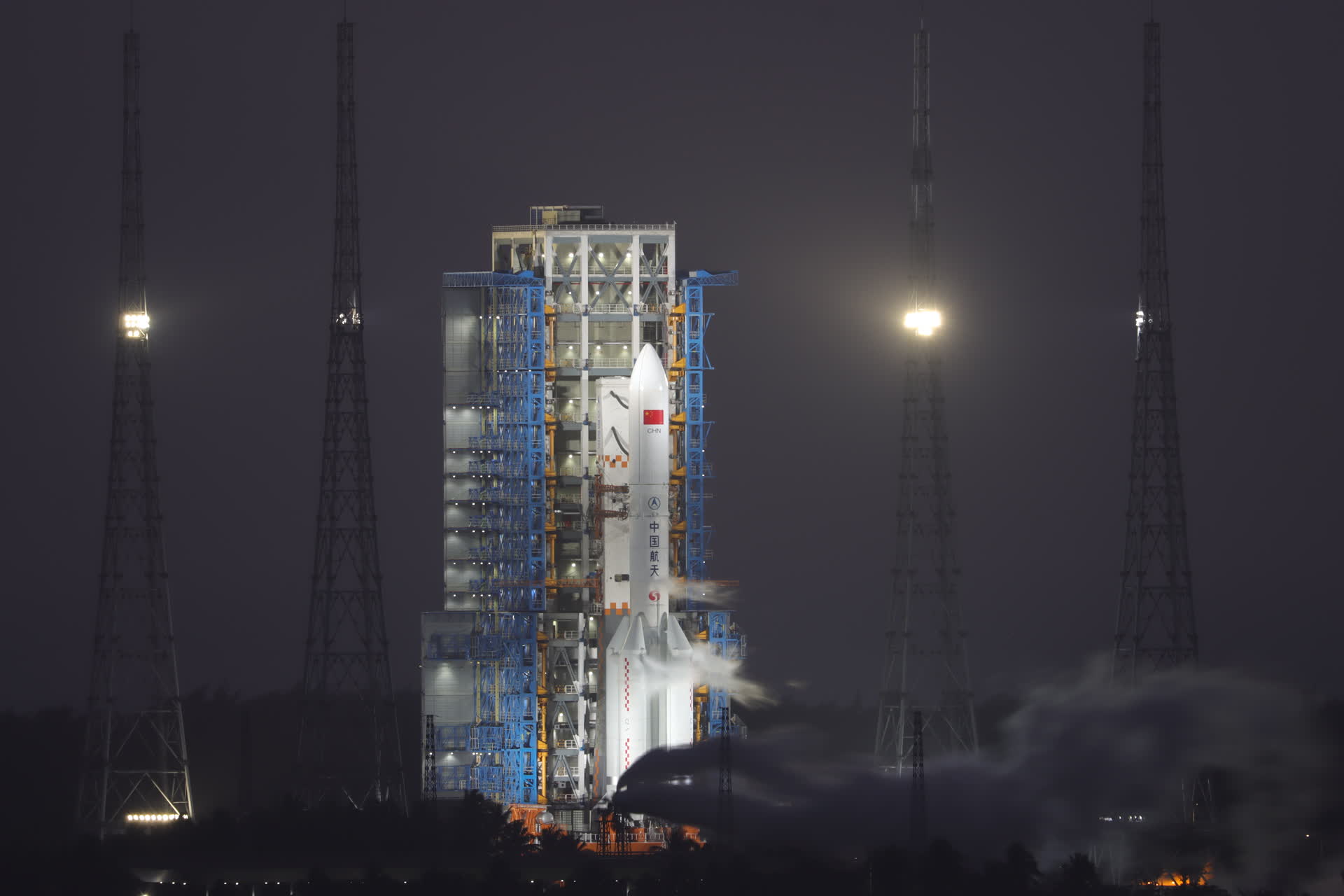
Long March 5 Y7 Carrier Rocket Launch Preparation on 23 February 2024.
“The United States uses the so-called threats from other countries as an excuse to expand its military power. China is firmly opposed to this.”
China is downplaying U.S. concerns over Beijing’s intentions in the space domain, and instead, claiming that the U.S. is the state most responsible for the militarization of space. The first excerpted article from Chinese state-owned media outlet The Paper, reported that General Stephen Whiting, Commander of the United States Space Force, expressed strong concerns about China’s rapid development of space military capabilities, describing China as a “major threat” in the space domain and the pace of development as “alarming.”[i] The second excerpt from China’s Ministry of Defense offers China’s official response. Senior Colonel Zhang Xiaogang, criticized the U.S. for using “so-called threats” from other countries as excuses to expand its own military power in space. Zhang also accused the U.S. as the biggest promoter of space militarization, while firmly asserting that China insists on the peaceful use of space, opposes a space arms race, and urges the U.S. to cease spreading false statements and to refrain from expanding its arms and war preparations in space. Chinese rhetoric of peaceful space development follows the release of the 2023 “Blue Book” by China’s Aerospace Science and Technology Corporation. The document declares China’s plans to conduct a record-breaking 100 launch missions in 2024, including 70 space mission launches, involving 290 spacecraft, and a series of major carrier rocket tests.[ii] China sent an experimental communication satellite into space on 23 February 2024. The launch marks the eleventh satellite launched by China under a classified military program, with no additional details publicly disclosed by state media, except that the satellite will primarily be used for “multi-band and high-speed communication technology experiments.”[iii] In the past six months, China has launched more than 15 Yaogan reconnaissance satellites, primarily to support the People’s Liberation Army’s Strategic Support Force.[iv] The Yaogan-41, launched on 20 December 2023, involved a military geostationary earth observation/signals intelligence satellite that provides unprecedented capabilities for tracking and identifying U.S. and allied movements in the Indo-Pacific region.[v]
Sources:
Yan Shanshan, “美高官:在这一领域,中国正以惊人速度发展 (US senior official: In this field, China is developing at astonishing speed),” The Paper (official Chinese site), 03 March 2024. https://www.thepaper.cn/newsDetail_forward_26540782
Stephen Whiting, commander of the US Space Command, testifies to the US SASC that China has “dramatically improved its ability to monitor, track and target US and allied forces on Earth and in orbit.” The top commander declared space as a “expanding security challenge”, with China and Russia identified as the main competitors. Space is now deemed the “core of security activities in all fields,” and China is committed to making progress in satellite meteorology, manned spaceflights, robotic space explorations, and the ability to track and target US and allied forces. Furthermore, General Whiting said that China “will reach world-class levels in all fields except a few areas of space technology by 2030.”
Ye Mengyuan, “美国是太空军事化战场化的最大推手” (The United States is the biggest promoter of militarization of space),” China Ministry of National Defense (Ministry of National Defense Website), 29 February 2024. http://www.mod.gov.cn/gfbw/qwfb/16289660.htmlSenior Colonel Zhang Xiaogang, deputy director of the Information Bureau of the Ministry of National Defense and spokesperson of the Ministry of National Defense, responded to a reporter’s question regarding China’s comments on the United States strategic competition in space, long range missiles, and anti-satellite weapons. Senior Colonel Zhang rebuffed the United States as having defined space as “combat territory” and developing and deploying offensive space weapons, organizing military offensive and defensive exercises and technological experiments, and maliciously tracking and dangerously approaching other countries’ spacecraft which creates risk of collision. He states that the United States is the biggest promoter of the militarization of space and the biggest threat to space security. Furthermore, he claims that China always insisted on the peaceful use of space, opposes a space arms race, and is actively promoting the building of community for mankind. He urges the United States to stop spreading false statements, stop expanding its arms and war preparation in space, and prevent damaging global strategic security and stability.
Notes:
[i] In his testimony, General Whiting identified both China and Russia as significant space competitors. He urgently raises the need for the U.S. to expand its military power, as well as to sustain and improve its capabilities and strength in the space field to maintain its competitive advantage. Wu Zhichao, “国防部:美国是太空军事化战场化的最大推手 (Ministry of Defense: America is Space Militarization’s Biggest Driver),” The Paper, 29 February 2024. https://www.thepaper.cn/newsDetail_forward_26506145
[ii] Feng Hu, “2024年预计实施100次发射!中国航天科技活动蓝皮书发布 (An Estimated 100 Launches Will Be Carried Out in 2024! China’s Aerospace Science and Technology Activities Released Blue Book),” China Economic Daily, 26 February 2024. http://www.ce.cn/xwzx/gnsz/gdxw/202402/26/t20240226_38912226.shtml
[iii] Ryan Woo, “China Launches Classified Communication Satellite with Powerful Rocket,” Reuters, 23 February 2024. https://www.reuters.com/technology/space/china-launches-classified-communication-satellite-with-powerful-rocket-2024-02-23/
[iv] To obtain a list of Chinese satellites and their purpose description, see NASA Space Science Data Coordinated Archive, NASA, 28 March 2024. https://nssdc.gsfc.nasa.gov/nmc/spacecraft/query
[v] Clayton Swope, “No Place to Hide: A Look into China’s Geosynchronous Surveillance Capabilities,” Center for Strategic and International Studies, 19 January 2024. https://www.csis.org/analysis/no-place-hide-look-chinas-geosynchronous-surveillance-capabilities
Image Information:
Image: Long March 5 Y7 Carrier Rocket Launch Preparation on 23 February 2024.
Source:
Attribution: CCA-SA 4.0 Intl.
